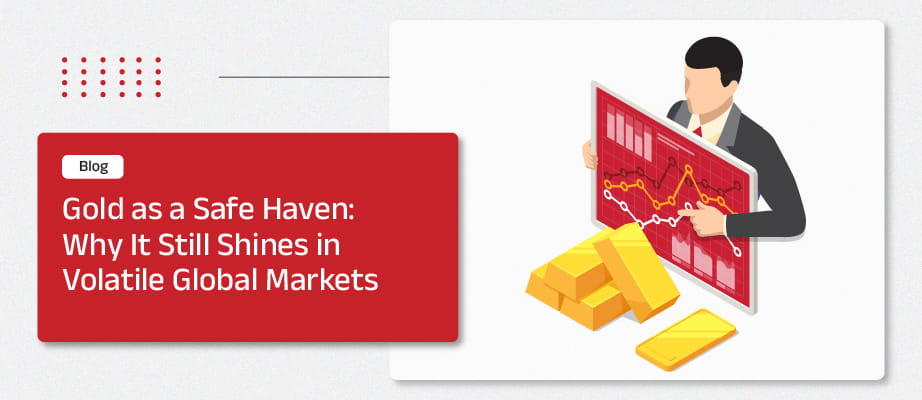-
Our Products
Our FundsFocus Funds
-
Self Care
Self-ServiceFind InformationWays To TransactPartner Solutions
-
Downloads
- Learnings
- About Us
-
More
-
Shareholders
-
Shareholders
-
Updates
-
-
SIP Calculators
- Back
-
Shareholders
Why gold remains the ultimate haven in a shifting global economy?

Jun 09, 2025
5 min
0 Rating
The substantial clamour for gold in recent times is more than just noise — it is backed by price action and investment flows. Over the past year, gold prices have surged over 30%1, recently touching all-time highs (crossing the Rs.1lac/10gm mark on April 22, 2025)2. This is not merely a speculative rally; it reflects growing global uncertainty and gold’s timeless role as a safe haven.
In fact, Indian investors are echoing this sentiment. Gold ETFs (Exchange Traded Funds) have seen a remarkable uptick in inflows, with their combined assets under management (AUM) nearly doubling over the past year3. Clearly, investors are turning to gold not just for safety, but also for stability and potential returns.
It is no coincidence that the last year has also been a year of major shifts in the global economic landscape
The past years has been one of tectonic shifts across the global economy. Several macroeconomic and geopolitical developments have pushed investors toward time-tested hedges like gold:
Deglobalization is accelerating
Countries are rethinking their supply chains and trade dependencies. Rising tariffs and protectionist policies — especially between major economies like the U.S. and China — are redrawing the rules of global commerce.
Tariff wars and regulatory tightening
This has increased trade friction. These changes are not just economic; they are structural, changing how nations engage with one another.
Geopolitical tensions
Conflict in regions like Eastern Europe and the Middle East and most recently between India and Pakistan have added further uncertainty to global markets.
Currency volatility
It has become the new norm. As interest rates fluctuate and sovereign debts mount, confidence in fiat currencies has weakened in many parts of the world.
In such a volatile and evolving environment, gold has not just remained relevant — it has reasserted its dominance as the go-to asset when stability is hard to find.
Why gold remains a safe haven in such times?
If there is one asset that has historically held strong — and even shone — through such disruptions, it is gold.
Gold holds when others fall
During times when equity markets stumble, currencies wobble, and bonds face rate risk, gold often rises. It is negatively correlated or uncorrelated with most other asset classes, making it an excellent diversification tool.
For instance, during the COVID-19 crash of 2020, while equity indices tumbled, gold not only held its ground but posted double-digit gains. Similar patterns were seen during the global financial crisis of 2008 and other high-volatility periods.2
Year
Average Gold price (24kt/10gm)
Annual growth
2020
50,151
28%
2019
39,108
2009
16,686
22%
2008
13,630
2008
13,630
29%
2007
10,598
An inflation hedge that has stood the test of time
While paper currencies can get devalued especially when country’s print more, gold’s supply is limited, giving it intrinsic value. Over centuries, gold has been a store of wealth that protects purchasing power, especially in inflationary environments.
When fiat currencies lose value, gold tends to retain — or even increase — its worth. That is why investors in both developed and emerging economies turn to gold during inflationary spikes.Backed by central banks worldwide
It is not just individual investors who are bullish on gold — central banks have been steadily accumulating gold to diversify their reserves. Global central bank gold purchases have been hitting historic highs, with demand exceeding 1,000t for three years in a row5.
This demand from monetary authorities underscores the strategic importance of gold, not just as a crisis hedge but also as a core asset in national portfolios.
Not Just Safe — Gold Also Delivers
Gold is often seen as defensive, but it is also a strong performer. Gold has delivered consistently, particularly during post-crisis recoveries. Over the last 10 years, gold has generated a CAGR of more ~13%.4
Its return profile, combined with its low volatility and diversification benefits, makes gold a powerful tool in any investor’s portfolio.
Gold Belongs in Every Portfolio
In a world that is constantly shifting — geopolitically, economically, and technologically — gold remains a constant. It is more than just a hedge; it is a time-tested asset that combines safety, stability, and strength.
As the global order recalibrates, gold’s relevance is only set to grow. Whether you are looking for capital preservation, inflation protection, or diversification — make sure gold, especially through Gold ETFs or funds, has a place in your portfolio.
Because in uncertain times, certainty is gold.
Sources:
1. May 8, 2024 – Rs.71,184/10gm and gold price on May 8,2025 – Rs.97,003 (more than 30% return) - https://www.goldpriceindia.com/gold-price-history.php
2. https://www.forbesindia.com/article/explainers/gold-rate-history-india/92539/1
3. AMFI monthly data – Gold ETFs AUM as on April 30th 2025 at Rs.61,422cr vs Rs.32,789cr as on April 30th, 2024
4. www.advisorkhoj.com – CAGR from 1 Jan 2005 till 8th May 2025 – 13.2%
5. https://www.gold.org/goldhub/research/gold-demand-trends/gold-demand-trends-full-year-2024/central-banks
Mutual Fund investments are subject to market risks, read all scheme related documents carefully.





 1800-270-7000
1800-270-7000



